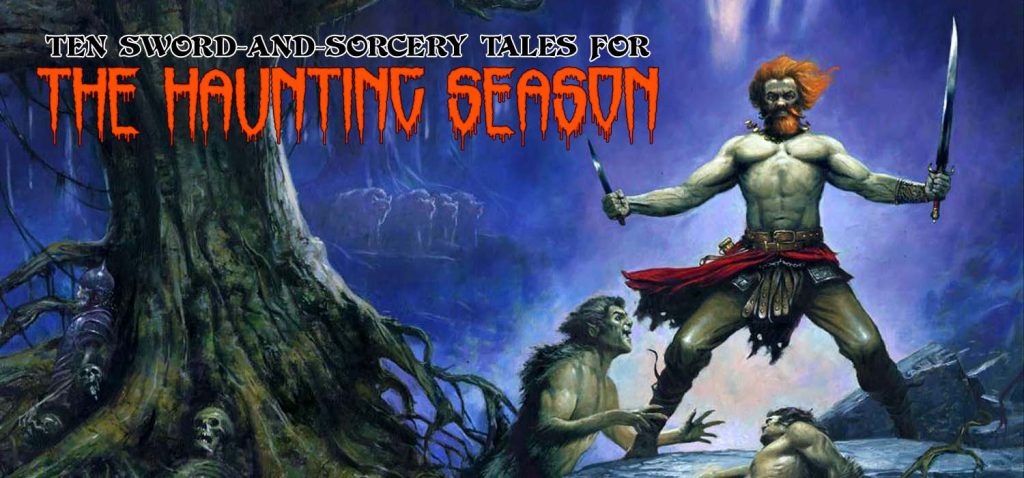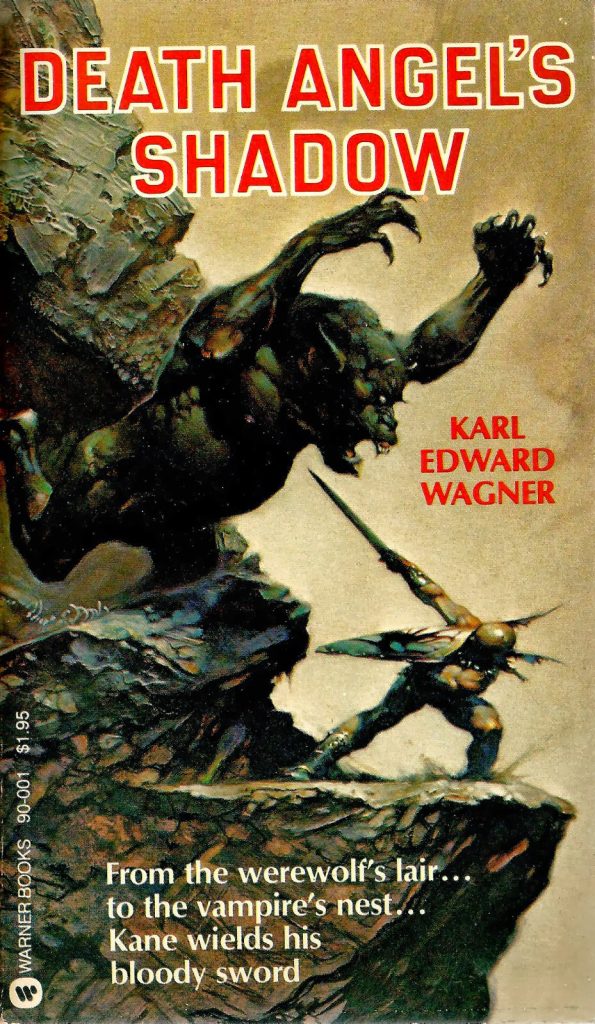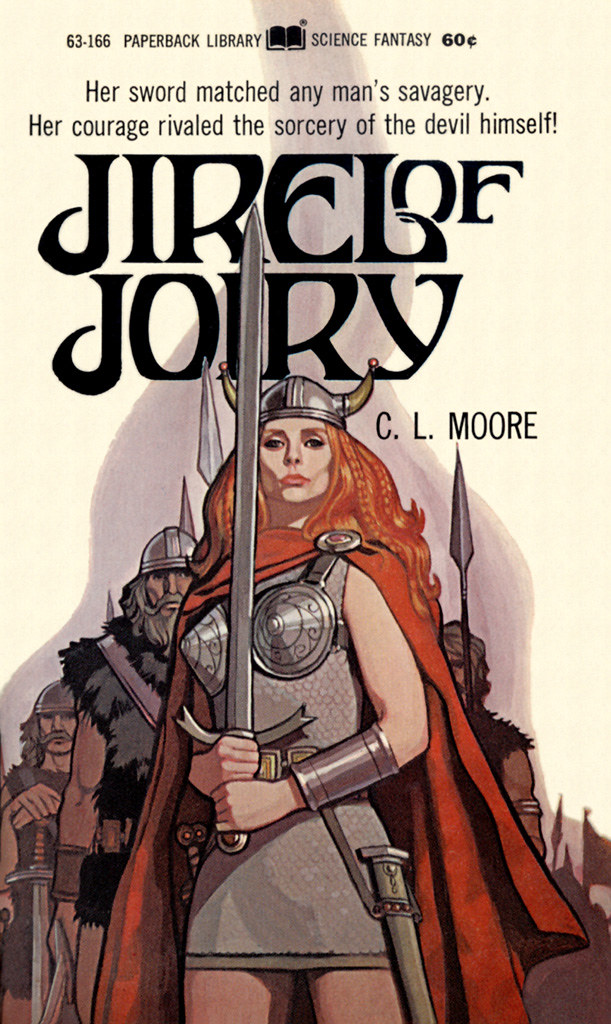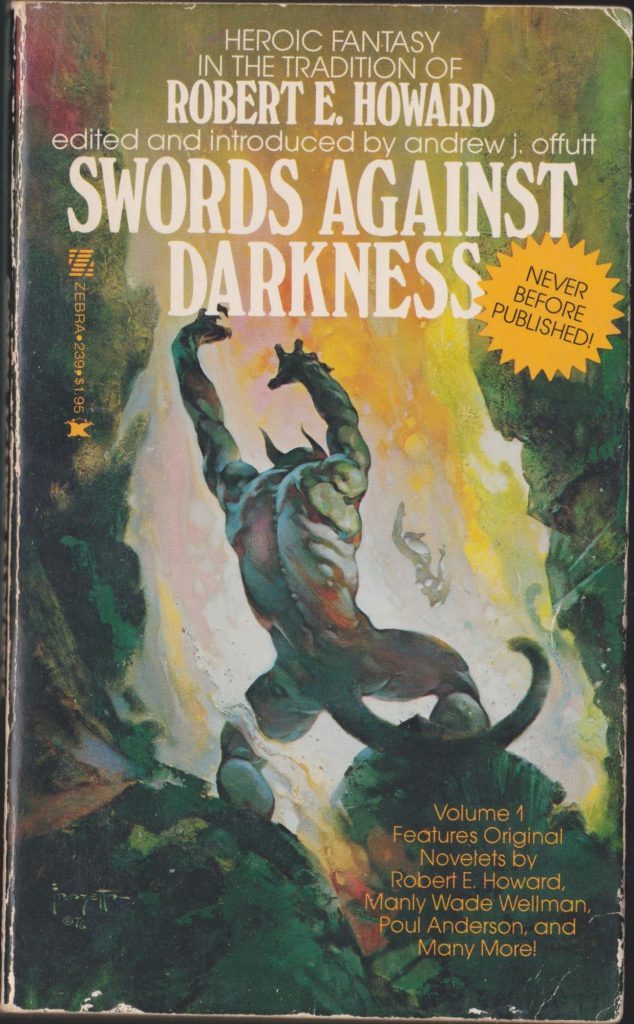Ten Sword-and-Sorcery Tales For the Haunting Season
by Brian Murphy
On a blog such as this, I doubt I’m alone in my irrational love of Halloween, a holiday for me that, more than Thanksgiving or Christmas, evokes a Ray Bradbury-like level of nostalgia and anticipation. Here in New England, I find that as the leaves begin to turn and October shadows lengthen, so too do my thoughts drift from my natural sword-and-sorcery bent toward the nether regions of horror. Edgar Allan Poe and Stephen King, classic Hammer movies and bad slasher films, bring it on, all of it.
But I’m also reminded that I need not necessarily choose between the two. Sword-and-sorcery after all is bedfellows with horror. Though he loathed the term, Karl Edward Wagner described S&S as “a fascinating synthesis of horror, adventure, and imagination … the common motif is a universe in which magic works and an individual may kill according to his personal code.” KEW’s parameters are broad enough to accommodate the likes of his own Kane, or Freddy Krueger (cut the man some slack, he had his reasons).
S&S can deliver the same delicious chill that results when we encounter the unknown and the irrational, or the grotesque, in the pages of horror fiction. Like that most desired of Halloween treats, these two flavors in the right proportions blend to create delicious reading.
Where did S&S acquire its heritage of horror? One source is H.P. Lovecraft. While not a sword-and-sorcery author, Lovecraft’s early Dream Cycle stories, which he referred to as his Dunsany phase, at times offered an effective blend of heroic fantasy and horror. In one such story, “The Doom that Came to Sarnath” (1920), the young warriors of Sarnath sack the ancient city of Ib and slaughter its loathsome residents. The warriors of Sarnath are no cringing, incredulous investigators, but men who slay without mercy and take back with them a green idol as a trophy for their city, ensuring their eventual doom. L. Sprague de Camp saw enough S&S in this tale to add to his seminal anthology Swords & Sorcery (1963), and it’s certainly not out of place there.
So without further ado, here are my Top 10 horror-infused sword-and-sorcery stories:
1. “Reflections for the Winter of My Soul,” Karl Edward Wagner.
A werewolf murder mystery played out amongst a group of suspicious guests, stranded in a castle in a driving snowstorm, and featuring the immortal and amoral Kane. Need I say more? KEW was a master of horror (see “Sticks” and “Where the Summer Ends”) and he blends that element successfully here to create a memorable S&S tale.
2. “The Barrow Troll,” David Drake.
Originally published in 1975 in Whispers magazine, a former periodical specializing in dark fantasy and horror, editor Stuart David Schiff described Drake’s story as “a brutal and shocking piece,” and that was precisely the effect it had and still has on me. A warning about the corruptive, corrosive dangers of hoarding wealth.
3. “Thieves House,” Fritz Leiber.
So much in here for the horror aficionado—the skull of Ohmphal with its great ruby eyes and pair of jeweled hands, blind wanderings through dry crypts, bats, mummies, murder, and a centuries-old vengeance fulfilled. Though I was tempted to go with “Ill Met in Lankhmar” due to its grisly twist, the discovery of two “longish heaps” of bloody flesh and bone, the remains of our hero’s love interests.
4. “The Beast of Averoigne,” Clark Ashton Smith.
Like Lovecraft, Smith is best classified as a horror author, but he also wrote some dark S&S including this tale from the May 1933 Weird Tales. It contains most of the subgenre’s classic trappings, including a medieval setting, horror, and monsters pitted against sorcery and steel. A portentous red comet passes near Averoigne—Smith’s fantastic stand-in for medieval France—and deposits an amorphous, shadowy beast that wreaks havoc by night. The monster kills and partially consumes beasts, then eventually men, women, and children. A local abbot enlists a sorcerer and two men-at-arms to summon a demon and put an end to the creature.
5. “Hellsgarde,” C.L. Moore.
I describe this tale as horror masquerading as S&S. It’s a terrifying tale of a revenant-haunted, hell-guarded castle that can only be come upon at night. Moore’s red-haired heroine Jirel, alone, must overcome her fears and enter. This passage says it all: “But—the mists between her and the castle had thickened, and her eyes might be playing her false—but were not those the shapes of men drawn up in a double row before the doorway of Hellsgarde? Hellsgarde, that had stood empty and haunted these two hundred years? Blinking through the dazzle of sun on water and the thickening of the mists, she rode on toward the gateway. She could feel the horse trembling between her knees, and with every step he grew more and more reluctant to go on. She set her teeth and forced him ahead resolutely, swallowing her own terror.”
6. “Worms of the Earth,” Robert E. Howard.
Howard was a very effective horror writer (see “Pigeons from Hell”) but also chilled with his sword-and-sorcery, perhaps nowhere better than this classic tale of Bran Mak Morn, who summons subhuman horrors to fulfill a near unhinged mission of vengeance against his Roman oppressors.
7. “Liane the Wayfarer,” Jack Vance.
Who hasn’t dreamt about running from some pursuing horror, but your legs seem to be caught in quicksand as the beast draws inexorably closer? Chun the Unavoidable is the stuff of nightmares, as are the eyeless victims of his murderous ways.
8. “The Sustenance of Hoak,” Ramsey Campbell.
Campbell is a modern master of weird horror, and when he applied his talents to S&S, writing for the likes of the Swords Against Darkness anthologies in the 1970s, it proved chillingly effective. “The Sustenance of Hoak” is unsettling, somewhat appalling, and therefore well-done. I am very glad to hear that his stories of Ryre, rare and hard to obtain, will be reprinted by the fine folks over at DMR.
9. “The Tale of Hauk,” Poul Anderson.
This oft-reprinted tale of a Viking chieftain, bitter at his “straw death” and back from the dead as a vengeful revenant, never fails to evoke terror. “Geirolf rocked into sight. The mould of the grave clung to him. His eyes stared unblinking, unmoving, blank in the moonlight, out of gray face whereon the skin crawled. The skipper’s come again…” Some hair-raising stuff from the great Anderson.
10. “The Gift of the Ob-Men,” Schuyler Hernstrom.
Hernstrom is a talented writer who gives me hope for the future of sword-and-sorcery. This story is something of a spiritual successor to “The Doom that Came to Sarnath,” with the main character, the warrior Sounnu, seeking to make amends for the wanton destruction of a strange race of mushroom men. Sounnu is an outcast, exiled for destroying an alien idol that through the centuries had become venerated among his people. It balances heroics with weird touches and an underlying futility and fatalistic world-view that leaves the reader unsettled.
So there you have it, ten sword-and-sorcery tales perfect for the witching season.
Brian Murphy is the author of Flame and Crimson: A History of Sword-and-Sorcery (Pulp Hero Press, 2020). Learn more about his life and work on his website, The Silver Key.










